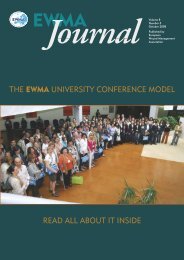best practice for the management of lymphoedema ... - EWMA
best practice for the management of lymphoedema ... - EWMA
best practice for the management of lymphoedema ... - EWMA
Create successful ePaper yourself
Turn your PDF publications into a flip-book with our unique Google optimized e-Paper software.
Introduction<br />
Lymphoedema is a progressive chronic<br />
condition that affects a significant number<br />
<strong>of</strong> people and can have deleterious effects on<br />
patients' physical and psychosocial health.<br />
Even though it may be greatly ameliorated by<br />
appropriate <strong>management</strong>, many patients<br />
receive inadequate treatment, are unaware<br />
that treatment is available or do not know<br />
where to seek help. Several recent systematic<br />
reviews have highlighted <strong>the</strong> distinct lack <strong>of</strong><br />
evidence <strong>for</strong> <strong>the</strong> optimal <strong>management</strong> <strong>of</strong><br />
<strong>lymphoedema</strong> 1-3 . By presenting a model <strong>for</strong><br />
<strong>best</strong> <strong>practice</strong> in <strong>lymphoedema</strong> in adults, this<br />
document aims to raise <strong>the</strong> pr<strong>of</strong>ile <strong>of</strong> <strong>the</strong><br />
condition and improve <strong>the</strong> care that patients<br />
receive.<br />
ABOUT THIS DOCUMENT<br />
The guidance provided here was derived<br />
from a UK national consensus on standards<br />
<strong>of</strong> <strong>practice</strong> <strong>for</strong> people who are at risk <strong>of</strong> or<br />
who have <strong>lymphoedema</strong> (Box 1). The<br />
consensus process (Box 2) was launched in<br />
2002 and was driven by <strong>the</strong> Lymphoedema<br />
Framework with input from national patient<br />
support groups, patients with<br />
<strong>lymphoedema</strong>, national pr<strong>of</strong>essional<br />
<strong>lymphoedema</strong> groups, clinical experts and<br />
industry (Appendix 1). Production <strong>of</strong> this<br />
document included review by an<br />
international panel <strong>of</strong> experts and<br />
endorsement by key national <strong>lymphoedema</strong><br />
organisations.<br />
The recommendations resulting from <strong>the</strong><br />
consensus approach are included where<br />
relevant. Each recommendation has been<br />
classified according to <strong>the</strong> UK NHS Health<br />
BOX 2 Consensus process<br />
The recommendations made in this document<br />
are <strong>the</strong> result <strong>of</strong> a highly rigorous, systematic<br />
process based on an explicit methodology <strong>of</strong><br />
consultation and consensus4 that involved:<br />
■ developing multidisciplinary, nationally<br />
representative groups<br />
■ identifying and critically appraising <strong>the</strong> <strong>best</strong><br />
available in<strong>for</strong>mation<br />
■ linking recommendations to supporting<br />
evidence<br />
Technology Assessment model <strong>for</strong> guideline<br />
development (Box 3) 4 .<br />
This document will be reviewed and<br />
updated after five years. Key references<br />
have been included; a complete list <strong>of</strong> <strong>the</strong><br />
references used in <strong>the</strong> preparation <strong>of</strong> <strong>the</strong><br />
text can be found at: www.lf.cricp.org.<br />
ABBREVIATIONS<br />
ABPI: ankle-brachial pressure index<br />
IPC: intermittent pneumatic compression<br />
MLD: manual lymphatic drainage<br />
MLLB: multi-layer inelastic <strong>lymphoedema</strong><br />
bandaging<br />
SLD: simple lymphatic drainage (self massage)<br />
TBPI: toe-brachial pressure index<br />
Standard 1: Identification <strong>of</strong> people at<br />
risk <strong>of</strong> or with <strong>lymphoedema</strong><br />
Systems to identify people at risk <strong>of</strong> or<br />
with <strong>lymphoedema</strong>, regardless <strong>of</strong> cause,<br />
will be implemented and monitored to<br />
ensure that patients receive high quality<br />
education and lifelong care<br />
Standard 2: Empowerment <strong>of</strong> people at<br />
risk <strong>of</strong> or with <strong>lymphoedema</strong><br />
Individual plans <strong>of</strong> care that foster self<strong>management</strong><br />
will be developed in<br />
partnership with patients at risk <strong>of</strong> or<br />
with <strong>lymphoedema</strong> (involving relatives<br />
and carers where appropriate), in an<br />
agreed <strong>for</strong>mat and language<br />
Standard 3: Provision <strong>of</strong> <strong>lymphoedema</strong><br />
services that deliver high quality clinical<br />
care that is subject to continuous<br />
improvement and integrates<br />
community, hospital and hospice based<br />
services<br />
All people at risk <strong>of</strong> or with<br />
<strong>lymphoedema</strong> will have access to trained<br />
healthcare pr<strong>of</strong>essionals, including<br />
<strong>lymphoedema</strong> specialists, who will work<br />
to agreed standards <strong>for</strong> comprehensive<br />
ongoing assessment, planning,<br />
education, advice, treatment and<br />
monitoring. Care will be <strong>of</strong> a high<br />
standard and subject to continuous<br />
quality improvement<br />
INTRODUCTION<br />
BOX 3 Classification <strong>of</strong><br />
recommendations4 A<br />
Clear research<br />
evidence<br />
B<br />
Limited supporting<br />
research evidence<br />
C<br />
Experienced common<br />
sense judgement<br />
BOX 1 Standards <strong>of</strong> <strong>practice</strong> <strong>for</strong> <strong>lymphoedema</strong> services, adapted from 5<br />
Standard 4: Provision <strong>of</strong> high quality<br />
clinical care <strong>for</strong> people with<br />
cellulitis/erysipelas<br />
Agreed protocols <strong>for</strong> <strong>the</strong> rapid and<br />
effective treatment <strong>of</strong> cellulitis/<br />
erysipelas, including prevention <strong>of</strong><br />
recurrent episodes, will be<br />
implemented and monitored by<br />
healthcare pr<strong>of</strong>essionals who have<br />
completed recognised training in this<br />
subject<br />
Standard 5: Provision <strong>of</strong> compression<br />
garments <strong>for</strong> people with<br />
<strong>lymphoedema</strong><br />
Agreed protocols <strong>for</strong> assessment <strong>for</strong><br />
and <strong>the</strong> provision <strong>of</strong> compression<br />
garments <strong>for</strong> people with<br />
<strong>lymphoedema</strong>, or where warranted,<br />
those at risk <strong>of</strong> <strong>lymphoedema</strong>, will be<br />
implemented and monitored<br />
Standard 6: Provision <strong>of</strong> multi-agency<br />
health and social care<br />
Following comprehensive assessment,<br />
any patient at risk <strong>of</strong> or with<br />
<strong>lymphoedema</strong> who requires multiagency<br />
support will have access to and<br />
receive care appropriate to <strong>the</strong>ir needs<br />
from health and social services<br />
BEST PRACTICE FOR THE MANAGEMENT OF LYMPHOEDEMA 1

















